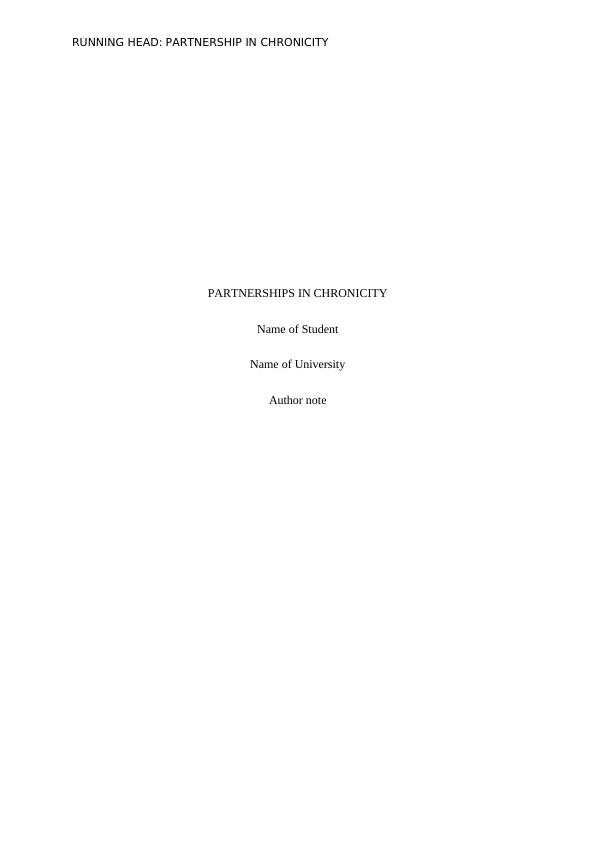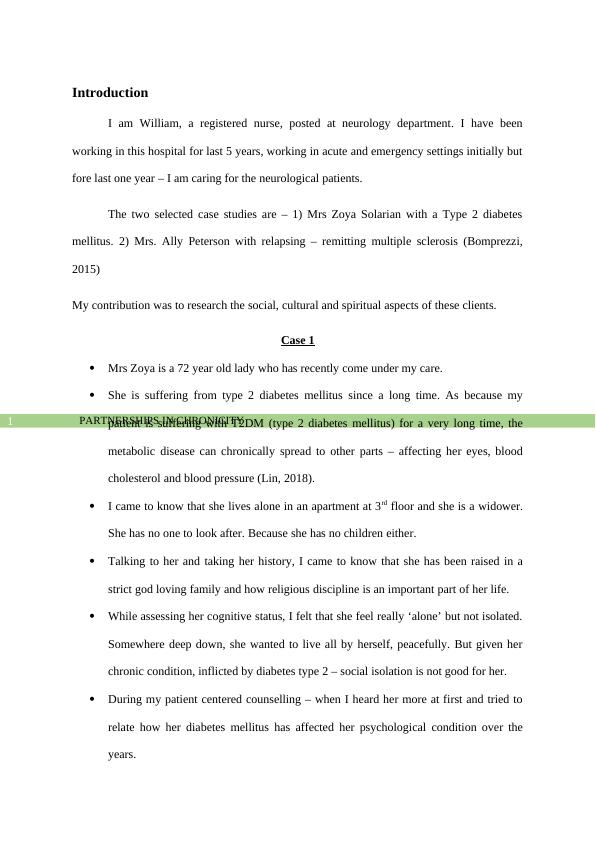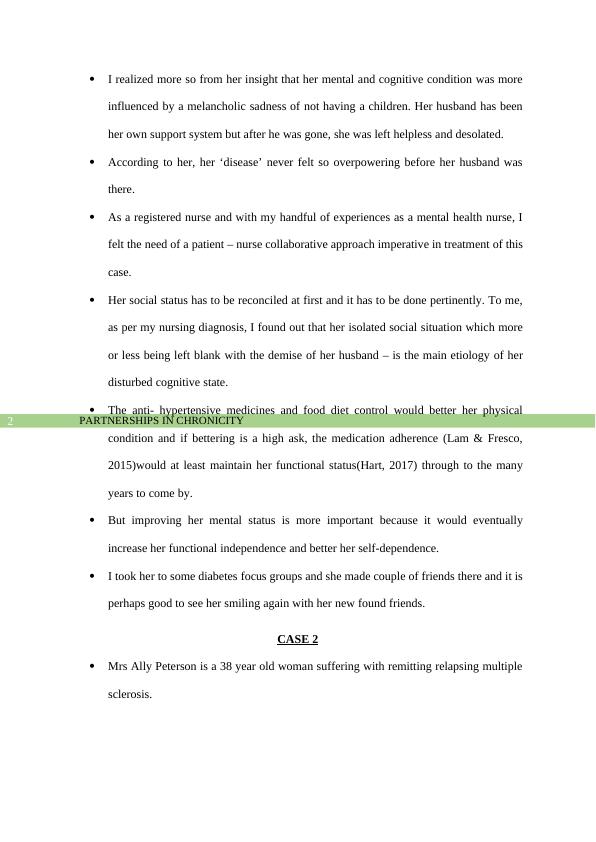Partnerships in Chronicity
Added on 2022-11-26
7 Pages1387 Words424 Views
RUNNING HEAD: PARTNERSHIP IN CHRONICITY
PARTNERSHIPS IN CHRONICITY
Name of Student
Name of University
Author note
PARTNERSHIPS IN CHRONICITY
Name of Student
Name of University
Author note

PARTNERSHIPS IN CHRONICITY1
Introduction
I am William, a registered nurse, posted at neurology department. I have been
working in this hospital for last 5 years, working in acute and emergency settings initially but
fore last one year – I am caring for the neurological patients.
The two selected case studies are – 1) Mrs Zoya Solarian with a Type 2 diabetes
mellitus. 2) Mrs. Ally Peterson with relapsing – remitting multiple sclerosis (Bomprezzi,
2015)
My contribution was to research the social, cultural and spiritual aspects of these clients.
Case 1
Mrs Zoya is a 72 year old lady who has recently come under my care.
She is suffering from type 2 diabetes mellitus since a long time. As because my
patient is suffering with T2DM (type 2 diabetes mellitus) for a very long time, the
metabolic disease can chronically spread to other parts – affecting her eyes, blood
cholesterol and blood pressure (Lin, 2018).
I came to know that she lives alone in an apartment at 3rd floor and she is a widower.
She has no one to look after. Because she has no children either.
Talking to her and taking her history, I came to know that she has been raised in a
strict god loving family and how religious discipline is an important part of her life.
While assessing her cognitive status, I felt that she feel really ‘alone’ but not isolated.
Somewhere deep down, she wanted to live all by herself, peacefully. But given her
chronic condition, inflicted by diabetes type 2 – social isolation is not good for her.
During my patient centered counselling – when I heard her more at first and tried to
relate how her diabetes mellitus has affected her psychological condition over the
years.
Introduction
I am William, a registered nurse, posted at neurology department. I have been
working in this hospital for last 5 years, working in acute and emergency settings initially but
fore last one year – I am caring for the neurological patients.
The two selected case studies are – 1) Mrs Zoya Solarian with a Type 2 diabetes
mellitus. 2) Mrs. Ally Peterson with relapsing – remitting multiple sclerosis (Bomprezzi,
2015)
My contribution was to research the social, cultural and spiritual aspects of these clients.
Case 1
Mrs Zoya is a 72 year old lady who has recently come under my care.
She is suffering from type 2 diabetes mellitus since a long time. As because my
patient is suffering with T2DM (type 2 diabetes mellitus) for a very long time, the
metabolic disease can chronically spread to other parts – affecting her eyes, blood
cholesterol and blood pressure (Lin, 2018).
I came to know that she lives alone in an apartment at 3rd floor and she is a widower.
She has no one to look after. Because she has no children either.
Talking to her and taking her history, I came to know that she has been raised in a
strict god loving family and how religious discipline is an important part of her life.
While assessing her cognitive status, I felt that she feel really ‘alone’ but not isolated.
Somewhere deep down, she wanted to live all by herself, peacefully. But given her
chronic condition, inflicted by diabetes type 2 – social isolation is not good for her.
During my patient centered counselling – when I heard her more at first and tried to
relate how her diabetes mellitus has affected her psychological condition over the
years.

PARTNERSHIPS IN CHRONICITY2
I realized more so from her insight that her mental and cognitive condition was more
influenced by a melancholic sadness of not having a children. Her husband has been
her own support system but after he was gone, she was left helpless and desolated.
According to her, her ‘disease’ never felt so overpowering before her husband was
there.
As a registered nurse and with my handful of experiences as a mental health nurse, I
felt the need of a patient – nurse collaborative approach imperative in treatment of this
case.
Her social status has to be reconciled at first and it has to be done pertinently. To me,
as per my nursing diagnosis, I found out that her isolated social situation which more
or less being left blank with the demise of her husband – is the main etiology of her
disturbed cognitive state.
The anti- hypertensive medicines and food diet control would better her physical
condition and if bettering is a high ask, the medication adherence (Lam & Fresco,
2015)would at least maintain her functional status(Hart, 2017) through to the many
years to come by.
But improving her mental status is more important because it would eventually
increase her functional independence and better her self-dependence.
I took her to some diabetes focus groups and she made couple of friends there and it is
perhaps good to see her smiling again with her new found friends.
CASE 2
Mrs Ally Peterson is a 38 year old woman suffering with remitting relapsing multiple
sclerosis.
I realized more so from her insight that her mental and cognitive condition was more
influenced by a melancholic sadness of not having a children. Her husband has been
her own support system but after he was gone, she was left helpless and desolated.
According to her, her ‘disease’ never felt so overpowering before her husband was
there.
As a registered nurse and with my handful of experiences as a mental health nurse, I
felt the need of a patient – nurse collaborative approach imperative in treatment of this
case.
Her social status has to be reconciled at first and it has to be done pertinently. To me,
as per my nursing diagnosis, I found out that her isolated social situation which more
or less being left blank with the demise of her husband – is the main etiology of her
disturbed cognitive state.
The anti- hypertensive medicines and food diet control would better her physical
condition and if bettering is a high ask, the medication adherence (Lam & Fresco,
2015)would at least maintain her functional status(Hart, 2017) through to the many
years to come by.
But improving her mental status is more important because it would eventually
increase her functional independence and better her self-dependence.
I took her to some diabetes focus groups and she made couple of friends there and it is
perhaps good to see her smiling again with her new found friends.
CASE 2
Mrs Ally Peterson is a 38 year old woman suffering with remitting relapsing multiple
sclerosis.

End of preview
Want to access all the pages? Upload your documents or become a member.
Related Documents
Role of the Community Nurselg...
|6
|1450
|65
Clinical Handoverlg...
|6
|1285
|92
The Use of ISBAR Components in Community Nursinglg...
|9
|2552
|363
Case Study on Diabetes: Impact, Needs, Goals, and Role of Nurseslg...
|9
|2785
|383
Psychosocial Impacts of Type 2 Diabetes Mellitus: A Case Studylg...
|17
|4564
|406
Case Study Essay on Acute Exacerbation of Chronic Heart Failurelg...
|7
|2040
|269
